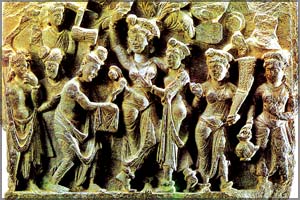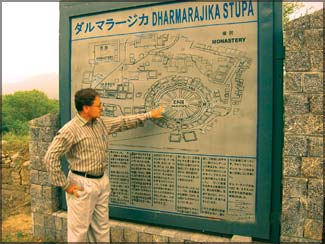A glimpse into grandeur of Taxila
Script and pictures Manjula Fernando
The journey began at 3 p.m. on April 5. Our destination was about
35km from the new Pakistani capital Islamabad. I was eagerly seated
inside a hired car to see and set my foot on the very sacred place where
the great Mauryan Emperor Asoka embraced Buddhism and sent out his
offspring on a mission of mercy.
I was attending a two-day seminar in Islamabad on an invitation by
the Pakistan Institute for Peace Studies. During the hectic sessions a
friend proposed that I should visit Taxila. It is a must place for any
Buddhist. Despite my reluctance to deviate from the initial program and
become a nuisance to the host I immediately responded ‘Is it possible?’.
|

Birth of Siddhartha |
|

Dharmarajika Stupa. Source: Buddhist Gandhara |
I later learned the place was not far and the journey to Taxila from
Islamabad would take less than two hours. My entire tour of Pakistan
lasted only four days; apart from the travelling time, I had two days
occupied by the seminar and related activities. But this was an
opportunity I could not afford to miss. Though an ardent Buddhist
myself, I am yet to make that sacred pilgrimage to Bodhgaya.
Uncertainty
Hence the trip to Taxila ruins was planned on the final day of the
seminar. It was a relief my presentation was scheduled on the first day.
The Taliban invasion in Swat was disturbing news at the time.
There was an air of uncertainty with reports of occasional terror
attacks in major cities. Given the situation my host suggested his
colleague Abdul Mateen, a former journalist be our escort. As planned, a
car was waiting outside the hotel at 2 p.m. We travelled past the
tree-line streets of Islamabad.
Well-built roads
The city is carefully planned and landscaped with a well-built roads
network. It was the summer in Pakistan, the Karachchi heat was
unbearable but Islamabad was a different story altogether. The
temperature fluctuated between 20-22C.
Halfway on we saw the unloading point of NATO military vehicles, the
camouflage jeeps were still stacked and wrapped in canvass on top of
long container carriers. After about a two-hour drive, we reached the
historic city Taxila, also known as Takshasila. This is one of the
subcontinent’s most important archaeological sites, with remains of
dozens of Buddhist monasteries dating from 600 BC to 600 AD.
Engineering
The city is also famous for the Heavy Industries Taxila (HIT), a
massive special weapons facility employing over 7000 highly skilled
workers, known as the backbone of Pakistan armed forces’ engineering
industry.
Malik Usther, a resident who had extensively studied and written on
the Buddhist ruins of Taxila, was waiting there for us. Usther said the
tale goes that Taxila was the place the Great emperor Asoka chose to
reside and where his son Arhath Mahinda set off on his religious mission
to Sri Lanka.
According to his account Islamic faith had travelled to Pakistan from
our tiny island nation. He proposed that our tour through the ancient
ruins should start from the Museum.
The place houses one of the best collections of Gandharan Buddhist
art in Pakistan. In here we came across dozens of clay statues of
Maithri Bodhisatva, Gothama Buddha, and work of art depicting his life’s
special moments; the prophesy of Suddodana’s ascetics, Queen Maha Maya’s
dream, the birth of Prince Siddhartha, the great departure and many
more.
Hostility
|

Malik Usther explaining the map. |
In this all Islamic nation it was astonishing to note the way the
Buddhist ruins have been preserved and protected. Contrary to reports of
hostility towards other faiths by Muslims, these ruins and the museum
draw quite a few local tourists, mainly families with children of school
age.
The closest of the ruins to the Museum is the Dharmarajika. This is a
site of a Buddhist stupa and a large monastery. A traveller has to
ascend a steep flight of stairs to reach the site. A hoarding erected by
the UNESCO at the entrance says this is the first and one of the largest
stupas built in Pakistan. It is believed Dharmarajika was built by the
great Emperor Asoka, in the 3rd century BC enclosing a small casket with
the holy ashes of the Buddha.
The main stupa here is 50 feet high and 165 feet in diameter. Around
this, there is a galaxy of smaller stupas said to be containing
different relics of the Buddha. Ruins of a large monastery lies on the
northern edge.
The water tank used by the monks for bathing with chambers like
changing rooms is an impressive structure that caught my eye in
particular. As we walked amid the buildings now reduced to just their
foundation and parts of walls, a sudden drizzle started descending from
the cloudy sky.
The thought crossed my mind that the place had been the tranquil home
of thousands of Buddhist disciples who followed the footsteps of the
Buddha and I was walking the same path they had roamed thousands of
years ago.
The place for its historic and architectural importance has been
declared a ‘protected antiquity’ since 1975 by the Government hence
making it a punishable offence to damage or deface ruins with not less
than three-year jail term with hard labour. Our next stop was at Jaulian
Monastery, a grand Sangarama, built in the second century AD during the
Kushana rule.
Establishment
This carefully planned monastery is spread on top of a sleek hill
with a serene overview of surrounding hills and valleys. The ruins of
this religious establishment suffice enough proof of the grandeur of the
then Buddhist reign.
|

Dharmarajika museum |
The main structure, which in its inception had been several storeys
high, consists of a huge assembly hall, shrine rooms, kitchen,
refectory, storeroom, bathroom, quarters for the kitchen aids.
A unique seated figure of a Gothama Buddha is also located in this
monastery. The statue of about 4 ft has a hole at the naval. Insertion
of a finger at this naval is believed to bring you blessings against
certain ailments.
Buddhist belief
I told our local friend this was against the Sri Lankan Buddhist
belief, and they respect any replica of the Buddha in veneration.
Remains of over two dozen monasteries could still be found in Taxila, a
place that accommodated over 1000 Buddhist monasteries.
Taxila is mentioned in the Maha Bharata and Ramayana for its
magnificence and wealth. The word Takshashila, in Sanskrit means
“belonging to the King Taksha”. Taksha was the son of Bharata and
Mandavi, as goes in Indian epic Ramayana.
In the epic Mahabharatha, the Kuru heir Parikit was enthroned at
Taxila. It is known as a key university town of Gandhara, a kingdom of
northern Pakistan from the 6th century BC to the 11the centrury AD.
Chandragupta Maurya, founder of the Mauryan empire in Eastern India,
made himself a master of the North and Northwest India, including
Punjab. Chandragupta Maurya’s advisor Kautilya / Chanakya was a teacher
at Taxila.
During the reign of Chandragupta’s grandson Asoka, Taxila became a
great Buddhist centre of learning.
Ancient sites
The famous treatise Arthashastra (A manual of Economics) by Kautilya,
is said to have been composed in Taxila. The city of Taxila is mentioned
by the Chinese monk Fa-Hsien, who visited ancient sites of Buddhism in
India. He came to Taxila in 405 CE.
Takshashila is described in some detail in later Jathaka tales,
written in Sri Lanka around the 5th century CE. It is believed that the
Mahayana sect of Buddhism took shape here. History has it that a student
entered Takshashila at 16.
The Vedas and the Eighteen Arts, which included skills such as
archery, hunting, and elephant-lore were taught in addition to its law
school, medical school and school of military science. The city and the
buildings were badly damaged by foreign invasions from time to time. |



